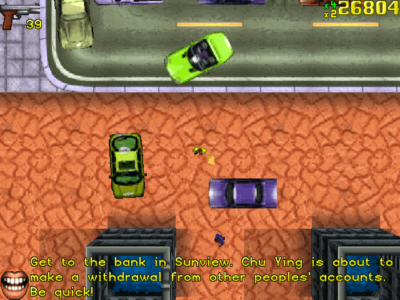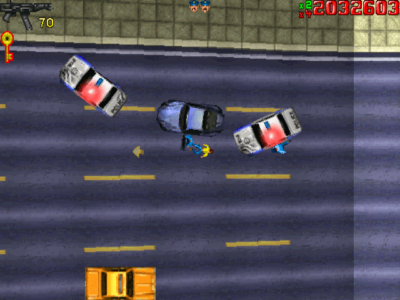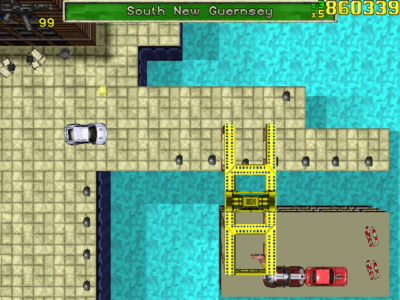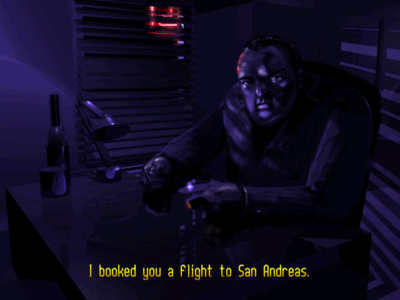Written by: Rik
Date posted: October 13, 2021
Well, here we are once more, looking back at an old write-up of an even older game, in celebration of FFG’s 20th anniversary.
That I’m going back to 2004 again, rather than 2001, says something about my productivity in the site’s early years, I guess, as we revisit Grand Theft Auto, a game that we apparently first covered in February of that year.
At that point, the rest of the world was going crazy for the next generation of GTA action, with GTA III and Vice City among the biggest-selling and most critically acclaimed titles of the early 00s, something acknowledged at the end of that review. We covered third game a couple of years ago, and to tie in with this retrospective, there’s also now a review of the 80s-flavoured follow-up.
My main memories of the 1997 original, and playing it for review, are that I always was quite bad at it and thought it a bit overrated. My ineptitude is only partially acknowledged in the review itself, and although the fact that the four featured screenshots all seem to have been taken from roughly 30 seconds into the opening level doesn’t look particularly good, I must stress that this was down to technical problems grabbing shots from the game (either getting them from the Win ’95 version was too difficult, or DOSBox and/or my machine struggled with running later DOS games at that point – I can’t really remember) rather than being representative of the amount of progress made.
Despite a reasonable investment of time, though, I can’t recall ever getting out of the first city, which might be why I made the basic factual error of saying that there are four cities in GTA when there are three: Liberty City, San Andreas and Vice City (based on New York, San Francisco and Miami respectively). I’ve changed it now, with the sneakiness in doing so partially offset by my admission here that the me of the past did indeed manage to get something so fundamental wrong.
To set things straight: there are two sets of missions in each city, so six ‘levels’ in all. To finish each one, there’s a target of points/cash you need to meet. The most reliable way of meeting these targets is by successfully completing missions, and by stringing together a succession of them without getting arrested or killed, which increases your score multiplier. This multiplier then applies to everything else you do in the game that scores points, which includes everything from minor shunts and bumps, to selling stolen cars at the docks (turning it from something that’s barely worth doing, as suggested in my original review, to a reasonable earner). If the law does catch up with you, then your multiplier is cut in half. And if you die, it’s the same, but you also lose one of your five lives as well.
Overlooking the core mechanics of the gameplay might be yet another of the many retro-crimes perpetrated by this website, but I can’t recall it being a major focus of contemporary coverage either, given that the headlines it attracted were down to the controversial content and the amount of freedom you were given to roam around each city.
It was the latter that was of greatest interest to me upon release, and fellow 90s gamers able to recall a time before the free exploration of big open worlds was the basis for most major action game releases will appreciate how much of a novelty this was back then. Being able to explore the city, drive different cars, get involved in scrapes with the police (and get out of them) – it all seemed amazing at the time, and many happy hours could be whiled away just seeing what was possible: can you jump the bridge in Liberty City (yes, with a good car and run-up), can you steal a limo and sell it at the docks (no, it won’t fit on the crane), will a car blow up if you get out and shoot it with your gun (yes, but it’s worth standing back).
At the risk of sounding like one of those dreary 8-bit retro bores claiming that nothing original has been released since the 80s (I rarely reach back that far into the past, because games were harder, I was younger, and I really was terrible at most of the games we had back then), I do recall being similarly entranced with a game on the CPC called Turbo Esprit, the point of which was to conduct drug busts, but it was also notable for the fact that you could drive your Lotus Esprit around seemingly functional cities.
I don’t think I ever actually intercepted any heroin (also, should a 7-year-old have been playing a game about heroin smuggling in the first place?) but instead had a blast driving around the city, sometimes just cruising around obeying traffic signals, and at other points causing as much chaos as possible, taking corners at high speed and blasting civilian cars with my machine gun. (Be sure to watch my YouTube video all about how *this* was the original GTA!!)
And so the story that I’ve told myself over the years about Grand Theft Auto is that it was a fun sandbox to mess around with, but the actual ‘game’ was severely flawed. Coming it back to it now, the prospect of mucking about, stealing random cars and going mad with a machine gun neither holds much appeal or seems that novel. And what comes into sharp focus instead is just how much of an old-school ‘game’ GTA actually is, one that relies on a combination of skill and strategy to get as many points as possible.
Indeed, putting fanciful notions of carefree capering aside, and approaching GTA very much as something to be tackled head-on and beaten, brought much more success this time around (although, full disclosure, I got no-where near the end). With only one shot at each mission, or set of missions, that start by answering one of the set of ringing phones in the park, it arguably takes a few plays (and cock-ups) to see what each involves before starting a new game with a planned running order and strategy for putting enough points together.
Failure in one doesn’t necessarily mean curtains for your chances of progressing, but if those failures start stacking up and you lose lives (and multipliers) along the way as well, then you could well end up getting stuck. Although in some missions, as long as there isn’t a time element, you can die or get busted midway through without the mission being interrupted, which is another mitigation against claims of unfair and punishing gameplay that I’d overlooked previously. And in the first city, at least, you do get clues on your pager to locations of non-phone missions, that start when you enter a parked car, if you’re close to the target total but out of other options.
Playing this directly alongside Vice City, it struck me both how similar and how different they are from each other. On the one hand, you can see how in some senses GTA III and Vice City are literally 3D versions of GTA: the nature of the missions, the behaviour of the police, and – particularly – the hit-and-miss combat and the vulnerability of your player character, which means that missions can go wrong very quickly and/or can occasionally be completed with a bit of a fluke. The fundamentals established here remain very much in place in later instalments.
But the lack of a mid-level save totally changes the nature of the action. In Vice City, where you can save regularly, your crime spree can feel relatively laid back, as you load up a save to have a quick go at a mission in a spare few minutes, with nothing lost if you fail to do so. By contrast, a level of GTA is a 45-minute stress headache: running around like a madman, working against the clock and the vagaries of each city’s layout in a desperate high-stakes battle to pull off each series of jobs, while, the vehicles’ various radio stations pump out a variety of anxiety-inducing music.
To be fair, it’s arguably a more accurate recreation of the precarious nature of a life of street crime, and more realistic than Vice City’s world of allowing you to go back to a mission that you just failed, without re-loading, as if that failure never happened. And there’s a certain independent spirit here that gradually became lost with the later games’ courting of Hollywood: you could almost imagine a gritty 2D indie reimagining of GTA that really ramped up the difficulty and focused on high scores rather than story progression.
Ultimately, though, while I came to appreciate GTA a little more this time around, I was never in any danger of trying to battle through to the end. Navigation was identified as a problem in my original write-up, and while modern technology allows you to have a PDF of the map on screen at the same time as your DOSBox window, I still found this aspect of the game extremely challenging. I had learned to look out for bridge signage, since the bulk of problems involve being on the wrong side of one while blindly following the guidance arrow, but still found myself getting stuck a bit too often for my liking.
Similarly, the level of traffic is heavier here. Again, something that’s possibly more realistic than the quiet roads of later 3D efforts, but when combined with the slightly wayward zoom in/out camera, it’s a recipe for collisions at almost every turn. You can see in the amount of damage that cars can take as well as the way that cops turn a blind eye to collisions that occur right in front of them (unless it involves them directly) that some concessions have been made to make up for the fact that driving is a generally tricky business.
And the on-foot action is even more precarious, with a single shot enough to put you down, unless you get hold of some armour. Running people over in a slightly cowardly manner is sometimes a viable option, although some gunfights take place in areas made inaccessible to vehicles. In which case, you better have an automatic weapon, because as far as I can see, shots from the pistol just pass through enemies and cause them no harm in the process.
Last time around, I said that GTA III and Vice City fix fundamental flaws in GTA that make the experience more enjoyable. I didn’t quite say, “start with those”, but I guess that was probably what I was thinking. Now, of course, Vice City is showing its age in some respects, and some may consider GTA IV and V better versions of the PS2-era games, which just shows the folly of reviews that assume that time stands still when making judgements about things becoming outdated. [Guilty, your honour – Ed.]
Revisiting GTA now gives me more of an appreciation for its scrappy charms, as well as being able to see it as a game which didn’t automatically lead to a big successful franchise full of Hollywood ideas and voice talent. As such, without ignoring any of the flaws and frustrations mentioned, I’d be more inclined these days to say that it’s worth another look, especially if you missed it first time around.
—
Grand Theft Auto is no longer available through official channels, so make of that what you will, and run it through DOSBox.






 Posts
Posts